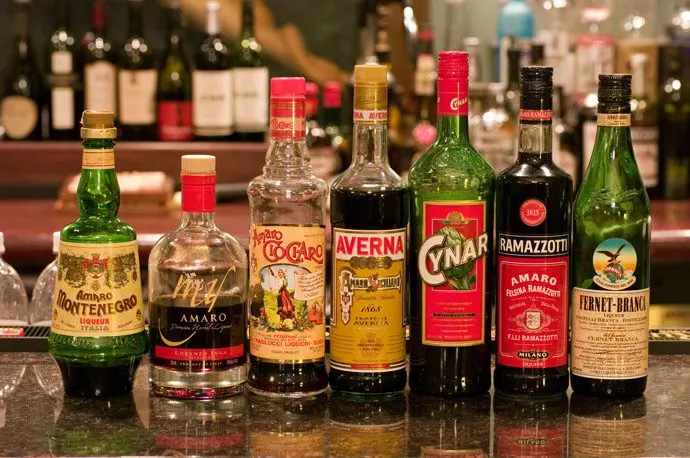Contents
Amaro (Amaro, translated from Italian – “bitter”) – Italian herbal liqueur, usually brown or black, with a strength of 16-45% vol. bitter-sweet taste, sometimes with a hint of cloying. Usually served as a digestif (after a meal to improve digestion). Analogues are produced throughout Europe: in Germany it is Kräuterlikör, in Hungary – Zwack Unicum, in Denmark – Gammeldansk, in France – Picon, but only Italian liqueurs can be called Amaro.
Peculiarities of taste
Up to several dozen aromatic herbs and roots are added to Amaro. Some manufacturers provide a detailed list of ingredients on the label, but this is not required. Common Ingredients: Gentian, Angelica, Spanish Artichoke, Cinchona, Lemon Balm, Lemon Verbena, Juniper, Anise, Fennel, Zinc Root, Ginger, Mint, Thyme, Sage, Laurel, Citrus Peel, Licorice, Cinnamon, Menthol, Cardamom , saffron, fragrant rue, wormwood, elderberry.
Technology of preparation
Amaro liqueurs are produced by maceration (infusion) of aromatic herbs, roots, flowers, bark and / or citrus peel on alcohol or wine. Then the infusion is filtered, sugar syrup is added to it and kept in barrels or bottles. The exact composition varies depending on the manufacturer, but many companies use old monastic or apothecary recipes.
The main rule is that any such liquor consists of three components: a strong base, bitter ingredients and sweet-flavored additives. The name does not refer to a specific brand – dozens of variations are available on the market. The most famous brands of Amaro: Averna, Ramazzotti, Lucano, Montenegro.
Amaro should not be confused with Amaretto, an Italian liqueur made from apricot kernels and/or almonds. You should also distinguish the drink from Amarone – dry red wine.
Types of Amaro
- Medium – Typically 32% ABV, balanced profile, equal parts sweet, bitter and citrusy. Examples: Montenegro, Ramazzotti, Averna, Lucano, Luxardo Amaro Abano, Amaro Bio.
- Fernet is a stronger variation, with a degree of up to 45%. Usually bitterness prevails in the taste profile. Examples: Fernet Branca, Fernet Stock, Luxardo Fernet, Amaro Santa Maria Al Monte.
- Light is a lighter and citrusy version. Examples: Amaro Nonino, Amaro Florio, Amaro del Capo.
- Alpine – with the addition of alpine herbs, sometimes with a smoky flavor, usually contains about 17% alcohol. Examples: Amaro Alpino, Amaro Zara, Amaro Braulio.
- Vermouth – unlike other types, it is made not on grain alcohol, but on wine. The taste is dominated by a sweet profile, citrus tones are clearly heard, the drink is very reminiscent of a vermouth aperitif, for example, Martini. Brands: Amero, Amaro Don Bairo, Amaro Diesus del Frate.
- Carciofo – made with artichokes, it often contains about 17% alcohol. Served as an aperitif, not a digestif. Examples: Cynar, Carciofo.
- Tartufo – made with the addition of black truffle, contains about 30%. Produced in the Italian region of Umbria and San Marino.
- China – with the addition of cinchona bark. The oldest and most popular brand is China Martini.
- Rabarbaro – with the addition of rhubarb. The famous brand is Zucca.
- Miscellaneous – Made with honey, fennel, or unripe walnuts.

Interesting Facts
- Famous drinks such as Campari or Aperol are also technically amaro.
- Herbal liqueurs are not a novelty of our time, people have been making tinctures on herbs and roots for thousands of years. The ancient Greeks and Romans used them for medical purposes; in medieval Europe, such elixirs often appeared at monasteries (Chartreuse, Benedictine).
- In Italy, there are more than 50 types of amaro liqueurs (in Italian, the plural form sounds like Amari).
- Amaro is not only drunk, but also added to various dishes and pastries.
- The Argentineans consider fernet cola to be their national cocktail.
- Commercial production of liqueurs began in the XNUMXth century, one of the first merchants who had a hand in this was Salvatore Averna.
How to drink Amaro liqueurs
Amaro is drunk neat with or without ice, also diluted with tonic or citrus juice. Served as a digestif, some types and as an aperitif (before meals for appetite).

As an appetizer, classic Italian dishes are best: risotto, pizza, spaghetti and lasagna.
Cocktails with Amaro
- Negroni (Negroni) – in an ice-filled shaker, mix equal parts of gin, Campari and sweet red vermouth, serve in an old fashioned glass, garnished with orange zest.
- Americano (Americano) – pour one part Campari and red sweet vermouth into a glass filled with ice, add two parts soda water, garnish with an orange slice or lemon zest.
- Aperol Spritz (Aperol Syringe) – in a tall glass (for example, a collins or a special glass for Aperol Spritz), put a few ice cubes, pour 3 parts prosecco or any other sparkling white wine, 2 parts Aperol, add soda to taste. Serve with an orange slice.
- Black Manhattan (Black Manhattan) – in a mixing glass, mix 2-2.5 parts of rye whiskey, 1 part of Averna liqueur, a couple of drops of angostura. Serve with ice in a cocktail glass.
- Hanky Panky (Hanky Panky) – In a mixing glass with ice, mix one part gin and sweet vermouth, 1-2 teaspoons of Fernet-Branca amaro. Serve in a cocktail glass garnished with orange zest.
- Boulevardier (Boulvardier) – in a glass of old fashioned, pour in succession one part of Campari and sweet vermouth, add 1 ¼ part of rye whiskey, mix gently, serve with orange zest.











